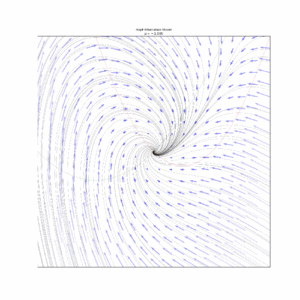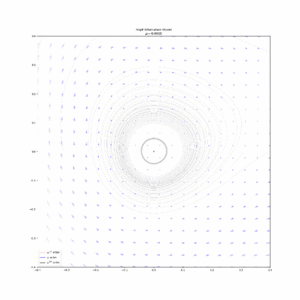Hopf bifurcation
In the mathematical theory of bifurcations, a Hopf bifurcation is a critical point where, as a parameter changes, a system's stability switches and a periodic solution arises.[1] More accurately, it is a local bifurcation in which a fixed point of a dynamical system loses stability, as a pair of complex conjugate eigenvalues—of the linearization around the fixed point—crosses the complex plane imaginary axis as a parameter crosses a threshold value. Under reasonably generic assumptions about the dynamical system, the fixed point becomes a small-amplitude limit cycle as the parameter changes.
A Hopf bifurcation is also known as a Poincaré–Andronov–Hopf bifurcation, named after Henri Poincaré, Aleksandr Andronov and Eberhard Hopf.
Overview
Supercritical and subcritical Hopf bifurcations

The limit cycle is orbitally stable if a specific quantity called the first Lyapunov coefficient is negative, and the bifurcation is supercritical. Otherwise it is unstable and the bifurcation is subcritical.
The normal form of a Hopf bifurcation is the following time-dependent differential equation:
- [math]\displaystyle{ \frac{dz}{dt}=z((\lambda + i ) + b |z|^2), }[/math] where z, b are both complex and λ is a real parameter.
Write: [math]\displaystyle{ b= \alpha + i \beta. \, }[/math] The number α is called the first Lyapunov coefficient.
- If α is negative then there is a stable limit cycle for λ > 0:
- [math]\displaystyle{ z(t) = r e^{i \omega t} \, }[/math]
- where
- [math]\displaystyle{ r=\sqrt{-\lambda/\alpha}\text{ and }\omega= 1 + \beta r^2. \, }[/math]
- The bifurcation is then called supercritical.
- If α is positive then there is an unstable limit cycle for λ < 0. The bifurcation is called subcritical.
Intuition

The normal form of the supercritical Hopf bifurcation can be expressed intuitively in polar coordinates,
- [math]\displaystyle{ \frac{dr}{dt} = (\mu-r^2)r , ~~ \frac{d\theta}{dt} = \omega }[/math]
where [math]\displaystyle{ r(t) }[/math] is the instantaneous amplitude of the oscillation and [math]\displaystyle{ \theta(t) }[/math] is its instantaneous angular position.[3] The angular velocity [math]\displaystyle{ (\omega) }[/math] is fixed. When [math]\displaystyle{ \mu\gt 0 }[/math], the differential equation for [math]\displaystyle{ r(t) }[/math] has an unstable fixed point at [math]\displaystyle{ r=0 }[/math] and a stable fixed point at [math]\displaystyle{ r=\sqrt\mu }[/math]. The system thus describes a stable circular limit cycle with radius [math]\displaystyle{ \sqrt \mu }[/math] and angular velocity [math]\displaystyle{ \omega }[/math]. When [math]\displaystyle{ \mu\lt 0 }[/math] then [math]\displaystyle{ r=0 }[/math] is the only fixed point and it is stable. In that case, the system describes a spiral that converges to the origin.
Cartesian coordinates
The polar coordinates can be transformed into Cartesian coordinates by writing [math]\displaystyle{ x=r\cos(\theta) }[/math] and [math]\displaystyle{ y=r\sin(\theta) }[/math].[3] Differentiating [math]\displaystyle{ x }[/math] and [math]\displaystyle{ y }[/math] with respect to time yields the differential equations,
- [math]\displaystyle{ \begin{align} \frac{dx}{dt} &= \frac{dr}{dt}\cos(\theta) - \frac{d\theta}{dt} r \sin(\theta) \\ &= (\mu - r^2) r \cos(\theta) - \omega r \sin(\theta) \\ &= (\mu - x^2 - y^2) x - \omega y \end{align} }[/math]
and
- [math]\displaystyle{ \begin{align} \frac{dy}{dt} &= \frac{dr}{dt}\sin(\theta) + \frac{d\theta}{dt} r \cos(\theta) \\ &= (\mu - r^2) r \sin(\theta) + \omega r \cos(\theta) \\ &= (\mu - x^2 - y^2) y + \omega x . \end{align} }[/math]
Subcritical case
The normal form of the subcritical Hopf is obtained by negating the sign of [math]\displaystyle{ dr/dt }[/math],
- [math]\displaystyle{ \frac{dr}{dt} = -(\mu-r^2)r , ~~ \frac{d\theta}{dt} = \omega }[/math]
which reverses the stability of the fixed points in [math]\displaystyle{ r(t) }[/math]. For [math]\displaystyle{ \mu\gt 0 }[/math] the limit cycle is now unstable and the origin is stable.
Example

Hopf bifurcations occur in the Lotka–Volterra model of predator–prey interaction (known as paradox of enrichment), the Hodgkin–Huxley model for nerve membrane potential,[4] the Selkov model of glycolysis,[5] the Belousov–Zhabotinsky reaction, the Lorenz attractor, the Brusselator, and in classical electromagnetism.[6] Hopf bifurcations have also been shown to occur in fission waves.[7]
The Selkov model is
- [math]\displaystyle{ \frac{dx}{dt} = -x + ay + x^2 y, ~~ \frac{dy}{dt} = b - a y - x^2 y. }[/math]
The figure shows a phase portrait illustrating the Hopf bifurcation in the Selkov model.[8]
In railway vehicle systems, Hopf bifurcation analysis is notably important. Conventionally a railway vehicle's stable motion at low speeds crosses over to unstable at high speeds. One aim of the nonlinear analysis of these systems is to perform an analytical investigation of bifurcation, nonlinear lateral stability and hunting behavior of rail vehicles on a tangent track, which uses the Bogoliubov method.[9]
Serial expansion method
Consider a system defined by [math]\displaystyle{ \ddot x + h(\dot x, x, \mu) = 0 }[/math], where [math]\displaystyle{ h }[/math] is smooth and [math]\displaystyle{ \mu }[/math] is a parameter. After a linear transform of parameters, we can assume that as [math]\displaystyle{ \mu }[/math] increases from below zero to above zero, the origin turns from a spiral sink to a spiral source.
Now, for [math]\displaystyle{ \mu \gt 0 }[/math], we perform a perturbative expansion using two-timing:[math]\displaystyle{ x(t) = \epsilon x_1(t, \nu t) + \epsilon^2 x_2(t, \nu t) + \cdots }[/math]where [math]\displaystyle{ \epsilon, \nu }[/math] are functions of [math]\displaystyle{ \mu }[/math]. By an argument with harmonic balance (see [10] for details), we can use [math]\displaystyle{ \epsilon = \mu^{1/2}, \nu = \mu }[/math]. Then, plugging in [math]\displaystyle{ x(t) }[/math] to [math]\displaystyle{ \ddot x + h(\dot x, x, \mu) = 0 }[/math], and expanding up to the [math]\displaystyle{ \epsilon^3 }[/math] order, we would obtain three ordinary differential equations in [math]\displaystyle{ x_1, x_2, x_3 }[/math].
The first equation would be of form [math]\displaystyle{ \partial_{tt} x_1 + \omega_0^2 x_1 = 0 }[/math], which gives the solution [math]\displaystyle{ x_1(t, T) = A(T) \cos(\omega_0 t + \phi(T)) }[/math], where [math]\displaystyle{ A(T), \phi(T) }[/math] are "slowly varying terms" of [math]\displaystyle{ x_1 }[/math]. Plugging it into the second equation, we can solve for [math]\displaystyle{ x_2(t, T) }[/math].
Then plugging [math]\displaystyle{ x_1, x_2 }[/math] into the third equation, we would have an equation of form [math]\displaystyle{ \partial_{tt} x_3 + \omega_0^2 x_3 = ... }[/math], with the right-hand-side a sum of trigonometric terms. Of these terms, we must set the "resonance term" -- that is, [math]\displaystyle{ \cos(\omega_0 t), \sin(\omega_0 t) }[/math] -- to zero. This is the same idea as Poincaré–Lindstedt method. This then provides two ordinary differential equations for [math]\displaystyle{ A, \phi }[/math], allowing one to solve for the equilibrium value of [math]\displaystyle{ A }[/math], as well as its stability.
Example
Consider the system defined by [math]\displaystyle{ \frac{d x}{d t}=\mu x+y-x^2 }[/math] and [math]\displaystyle{ \frac{d y}{d t}=-x+\mu y+2 x^2 }[/math]. The system has an equilibrium point at origin. When [math]\displaystyle{ \mu }[/math] increases from negative to positive, the origin turns from a stable spiral point to an unstable spiral point.
First, we eliminate [math]\displaystyle{ y }[/math] from the equations:[math]\displaystyle{ \frac{d x}{d t}=\mu x+y-x^2 \implies \ddot x = \mu \dot x + (-x + \mu y + 2x^2)- 2x\dot x \implies \ddot x - 2\mu \dot x + (1+\mu^2)x + 2x\dot x - (2 + \mu )x^2 = 0 }[/math]Now, perform the perturbative expansion as described above:[math]\displaystyle{ x(t) = \epsilon x_1(t, T) + \epsilon^2 x_2(t, T) + \cdots }[/math]with [math]\displaystyle{ \epsilon = \mu^{1/2}, T = \mu t }[/math]. Expanding up to order [math]\displaystyle{ \epsilon^3 }[/math], we obtain:[math]\displaystyle{ \begin{cases} \partial_{tt}x_1 + x_1 = 0\\ \partial_{tt}x_2+ x_2 = 2x_1^2 - 2x_1 \partial_t x_1\\ \partial_{tt}x_3 + x_3 = 4x_1x_2 + 2\partial_t(x_1-x_1x_2 - \partial_T x_1) \end{cases} }[/math]First equation has solution [math]\displaystyle{ x_1(t, T) = A(T) \cos(t + \phi(T)) }[/math]. Here [math]\displaystyle{ A(T), \phi(T) }[/math] are respectively the "slow-varying amplitude" and "slow-varying phase" of the simple oscillation.
Second equation has solution [math]\displaystyle{ x_1(t, T) = B \cos(t + \theta) + A^2 - \frac 13 A^2(\sin(2t+2\phi) + \cos(2t+2\phi)) }[/math], where [math]\displaystyle{ B, \theta }[/math] are also slow-varying amplitude and phase. Now, since [math]\displaystyle{ x = \epsilon x_1 + \epsilon^2 x_2 + \cdots = \epsilon(A \cos(t + \phi) + \epsilon B\cos(t+\theta)) + \cdots }[/math], we can merge the two terms [math]\displaystyle{ A \cos(t + \phi) + \epsilon B\cos(t+\theta) }[/math] as some [math]\displaystyle{ C \cos(t + \xi) }[/math].
Thus, without loss of generality, we can assume [math]\displaystyle{ B = 0 }[/math]. Thus[math]\displaystyle{ x_2(t, T) = A^2 - \frac 13 A^2(\sin(2t+2\phi) + \cos(2t+2\phi)) }[/math]Plug into the third equation, we obtain[math]\displaystyle{ \partial_t^2 x_3 + x_3 + (2A-A^3-2A')\sin(t+\phi)- (2A\phi' +11A^3/3)\cos(t+\phi)+\frac 13 A^3(5\sin(3t+3\phi)-\cos(3t+3\phi)) }[/math]Eliminating the resonance terms, we obtain [math]\displaystyle{ A' = A-A^3/2, \quad \phi' = -\frac{11}{6}A^2 }[/math]The first equation shows that [math]\displaystyle{ A= \sqrt 2 }[/math] is a stable equilibrium. Thus we find that the Hopf bifurcation creates an attracting (rather than repelling) limit cycle.
Plugging in [math]\displaystyle{ A= \sqrt 2 }[/math], we have [math]\displaystyle{ \phi = -\frac{11}{3}T + \phi_0 }[/math]. We can repick the origin of time to make [math]\displaystyle{ \phi_0 = 0 }[/math]. Now solve for [math]\displaystyle{ \partial_t^2 x_3 + x_3 + \frac 13 A^3(5\sin(3t+3\phi)-\cos(3t+3\phi)) }[/math]yielding[math]\displaystyle{ x_3 = \frac{\sqrt 2}{12}(5\sin(3t + 3\phi)-\cos(3t + 3\phi)) }[/math]Plugging in [math]\displaystyle{ A= \sqrt 2 }[/math] back to the expressions for [math]\displaystyle{ x_1, x_2 }[/math], we have[math]\displaystyle{ x_1 = \sqrt 2 \cos(t+\phi), \quad x_2 = 2-\frac 23 (\sin(2t+2\phi) + \cos(2t+2\phi)) }[/math]Plugging them back to [math]\displaystyle{ y = x^2 + \dot x - \mu x }[/math] yields the serial expansion of [math]\displaystyle{ y }[/math] as well, up to order [math]\displaystyle{ \mu^{3/2} }[/math].
Letting [math]\displaystyle{ \theta := t + \phi }[/math] for notational neatness, we have
[math]\displaystyle{ \begin{aligned} x &= &\mu^{1/2} \sqrt{2} \cos\theta + &\mu \left(2-\frac 23 \sin(2\theta)-\frac 23 \cos(2\theta)\right) + &\mu^{3/2}\frac{1}{\sqrt{72}} (5\sin(3\theta) - \cos(3\theta))+&O(\mu^2)\\ y &= &-\mu^{1/2} \sqrt{2} \sin\theta + &\mu \left(1+\frac 43 \sin(2\theta)-\frac 13 \cos(2\theta)\right) + &\mu^{3/2}\frac{1}{\sqrt{72}} (36\sin\theta + 28\cos\theta - 5\sin(3\theta) + 7\cos(3\theta)) + &O(\mu^2) \end{aligned} }[/math]
This provides us with a parametric equation for the limit cycle. This is plotted in the illustration on the right.
- Examples of bifurcations
A Hopf bifurcation occurs in the system [math]\displaystyle{ \frac{d x}{d t}=\mu x+y-x^2 }[/math] and [math]\displaystyle{ \frac{d y}{d t}=-x+\mu y+2 x^2 }[/math], when [math]\displaystyle{ \mu = 0 }[/math], around the origin. A homoclinic bifurcation occurs around [math]\displaystyle{ \mu = 0.06605695 }[/math].
Definition of a Hopf bifurcation
The appearance or the disappearance of a periodic orbit through a local change in the stability properties of a fixed point is known as the Hopf bifurcation. The following theorem works for fixed points with one pair of conjugate nonzero purely imaginary eigenvalues. It tells the conditions under which this bifurcation phenomenon occurs.
Theorem (see section 11.2 of [11]). Let [math]\displaystyle{ J_0 }[/math] be the Jacobian of a continuous parametric dynamical system evaluated at a steady point [math]\displaystyle{ Z_e }[/math]. Suppose that all eigenvalues of [math]\displaystyle{ J_0 }[/math] have negative real part except one conjugate nonzero purely imaginary pair [math]\displaystyle{ \pm i\beta }[/math]. A Hopf bifurcation arises when these two eigenvalues cross the imaginary axis because of a variation of the system parameters.
Routh–Hurwitz criterion
Routh–Hurwitz criterion (section I.13 of [12]) gives necessary conditions so that a Hopf bifurcation occurs.[13]
Sturm series
Let [math]\displaystyle{ p_0,~p_1,~\dots~,~p_k }[/math] be Sturm series associated to a characteristic polynomial [math]\displaystyle{ P }[/math]. They can be written in the form:
- [math]\displaystyle{ p_i(\mu)= c_{i,0} \mu^{k-i} + c_{i,1} \mu^{k-i-2} + c_{i,2} \mu^{k-i-4}+\cdots }[/math]
The coefficients [math]\displaystyle{ c_{i,0} }[/math] for [math]\displaystyle{ i }[/math] in [math]\displaystyle{ \{1,~\dots~,~k\} }[/math] correspond to what is called Hurwitz determinants.[13] Their definition is related to the associated Hurwitz matrix.
Propositions
Proposition 1. If all the Hurwitz determinants [math]\displaystyle{ c_{i,0} }[/math] are positive, apart perhaps [math]\displaystyle{ c_{k,0} }[/math] then the associated Jacobian has no pure imaginary eigenvalues.
Proposition 2. If all Hurwitz determinants [math]\displaystyle{ c_{i,0} }[/math] (for all [math]\displaystyle{ i }[/math] in [math]\displaystyle{ \{0,~\dots~,~k-2\} }[/math] are positive, [math]\displaystyle{ c_{k-1,0}=0 }[/math] and [math]\displaystyle{ c_{k-2,1}\lt 0 }[/math] then all the eigenvalues of the associated Jacobian have negative real parts except a purely imaginary conjugate pair.
The conditions that we are looking for so that a Hopf bifurcation occurs (see theorem above) for a parametric continuous dynamical system are given by this last proposition.
Example
Consider the classical Van der Pol oscillator written with ordinary differential equations:
- [math]\displaystyle{ \left \{ \begin{array}{l} \dfrac{dx}{dt} = \mu (1-y^2)x - y, \\ \dfrac{dy}{dt} = x. \end{array} \right . }[/math]
The Jacobian matrix associated to this system follows:
- [math]\displaystyle{ J = \begin{pmatrix} -\mu (-1+y^2) & -2 \mu y x -1 \\ 1 & 0 \end{pmatrix}. }[/math]
The characteristic polynomial (in [math]\displaystyle{ \lambda }[/math]) of the linearization at (0,0) is equal to:
- [math]\displaystyle{ P(\lambda) = \lambda^2 - \mu \lambda + 1. }[/math]
The coefficients are:
[math]\displaystyle{ a_0=1, a_1=-\mu, a_2=1 }[/math]
The associated Sturm series is:
- [math]\displaystyle{ \begin{array}{l} p_0(\lambda)=a_0 \lambda^2 -a_2 \\ p_1(\lambda)=a_1 \lambda \end{array} }[/math]
The Sturm polynomials can be written as (here [math]\displaystyle{ i=0,1 }[/math]):
- [math]\displaystyle{ p_i(\mu)= c_{i,0} \mu^{k-i} + c_{i,1} \mu^{k-i-2} + c_{i,2} \mu^{k-i-4}+\cdots }[/math]
The above proposition 2 tells that one must have:
- [math]\displaystyle{ c_{0,0} = 1 \gt 0, c_{1,0}=- \mu = 0, c_{0,1}=-1 \lt 0. }[/math]
Because 1 > 0 and −1 < 0 are obvious, one can conclude that a Hopf bifurcation may occur for Van der Pol oscillator if [math]\displaystyle{ \mu = 0 }[/math].
See also
- Reaction–diffusion systems
References
- ↑ "Hopf Bifurcations.". MIT. https://ocw.mit.edu/courses/mathematics/18-385j-nonlinear-dynamics-and-chaos-fall-2004/lecture-notes/hopfbif.pdf.
- ↑ Heitmann, S., Breakspear, M (2017-2022) Brain Dynamics Toolbox. bdtoolbox.org doi.org/10.5281/zenodo.5625923
- ↑ 3.0 3.1 Strogatz, Steven H. (1994). Nonlinear Dynamics and Chaos. Addison Wesley. ISBN 978-0-7382-0453-6. https://archive.org/details/nonlineardynamic00stro.
- ↑ Guckenheimer, J.; Labouriau, J.S. (1993), "Bifurcation of the Hodgkin and Huxley equations: A new twist", Bulletin of Mathematical Biology 55 (5): 937–952, doi:10.1007/BF02460693.
- ↑ "Selkov Model Wolfram Demo". [demonstrations.wolfram.com ]. http://demonstrations.wolfram.com/HopfBifurcationInTheSelkovModel/.
- ↑ López, Álvaro G (2020-12-01). "Stability analysis of the uniform motion of electrodynamic bodies" (in en). Physica Scripta 96 (1): 015506. doi:10.1088/1402-4896/abcad2. ISSN 1402-4896. https://doi.org/10.1088/1402-4896/abcad2.
- ↑ Osborne, Andrew G.; Deinert, Mark R. (October 2021). "Stability instability and Hopf bifurcation in fission waves" (in en). Cell Reports Physical Science 2 (10): 100588. doi:10.1016/j.xcrp.2021.100588. Bibcode: 2021CRPS....200588O.
- ↑ For detailed derivation, see Strogatz, Steven H. (1994). Nonlinear Dynamics and Chaos. Addison Wesley. p. 205. ISBN 978-0-7382-0453-6. https://archive.org/details/nonlineardynamic00stro/page/205.
- ↑ Serajian, Reza (2011). "Effects of the bogie and body inertia on the nonlinear wheel-set hunting recognized by the hopf bifurcation theory". International Journal of Automotive Engineering 3 (4): 186–196. http://www.iust.ac.ir/ijae/article-1-25-en.pdf.
- ↑ 10.0 10.1 18.385J / 2.036J Nonlinear Dynamics and Chaos Fall 2014: Hopf Bifurcations. MIT OpenCourseWare
- ↑ Hale, J.; Koçak, H. (1991). Dynamics and Bifurcations. Texts in Applied Mathematics. 3. Berlin: Springer-Verlag. ISBN 978-3-540-97141-2. https://archive.org/details/dynamicsbifurcat0000hale.
- ↑ Hairer, E.; Norsett, S. P.; Wanner, G. (1993). Solving Ordinary Differential Equations I: Nonstiff Problems (Second ed.). New York: Springer-Verlag. ISBN 978-3-540-56670-0.
- ↑ 13.0 13.1 Kahoui, M. E.; Weber, A. (2000). "Deciding Hopf bifurcations by quantifier elimination in a software component architecture". Journal of Symbolic Computation 30 (2): 161–179. doi:10.1006/jsco.1999.0353.
Further reading
- Guckenheimer, J.; Myers, M.; Sturmfels, B. (1997). "Computing Hopf Bifurcations I". SIAM Journal on Numerical Analysis 34 (1): 1–21. doi:10.1137/S0036142993253461.
- Hale, J.; Koçak, H. (1991). Dynamics and Bifurcations. Texts in Applied Mathematics. 3. Berlin: Springer-Verlag. ISBN 978-3-540-97141-2. https://archive.org/details/dynamicsbifurcat0000hale.
- Hassard, Brian D.; Kazarinoff, Nicholas D.; Wan, Yieh-Hei (1981). Theory and Applications of Hopf Bifurcation. New York: Cambridge University Press. ISBN 0-521-23158-2. https://books.google.com/books?id=3wU4AAAAIAAJ.
- Kuznetsov, Yuri A. (2004). Elements of Applied Bifurcation Theory (Third ed.). New York: Springer-Verlag. ISBN 978-0-387-21906-6.
- Strogatz, Steven H. (1994). Nonlinear Dynamics and Chaos. Addison Wesley. ISBN 978-0-7382-0453-6. https://archive.org/details/nonlineardynamic00stro.
External links
 |





